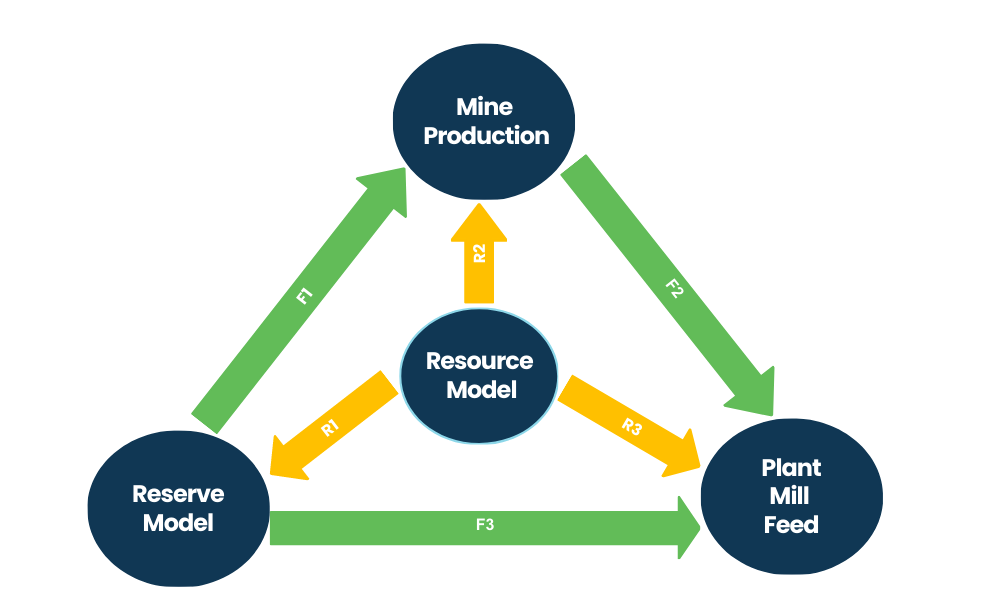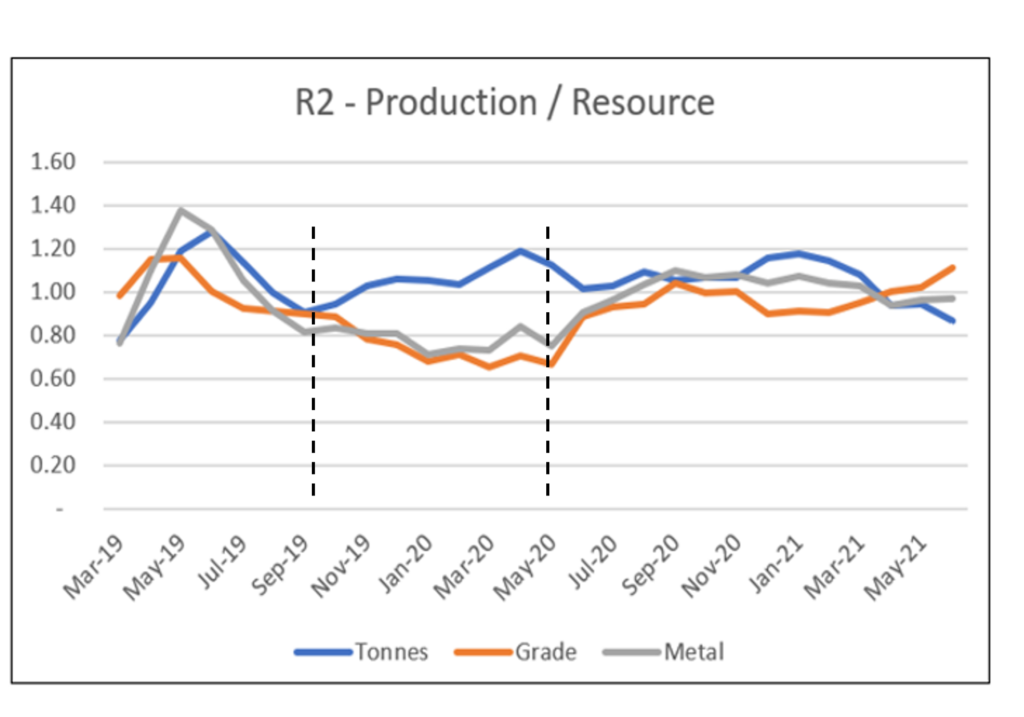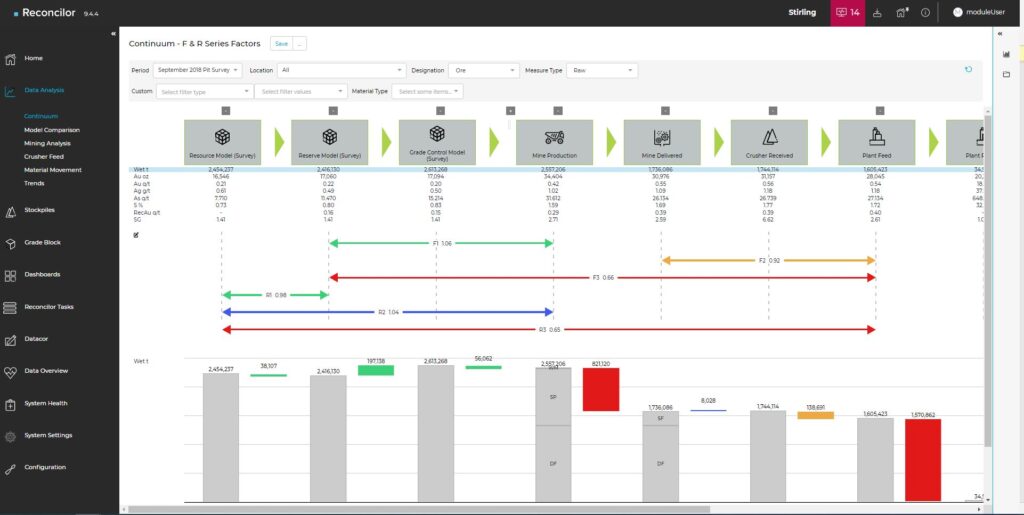

Mine reconciliation is a well-established process in modern mining operations. However, the resource sector lacks a standardized approach for reporting factors that can be used to assess model accuracy and metal recovery. While mine operators often use Parker’s F Series ratios, they are rarely shared externally due to the absence of accepted formal definitions. This blog post proposes an extension to the reconciliation process by introducing resource ratios, known as the R Series factors, to quantify the long-term impact of the information effect, dilution, and ore loss.
In order to facilitate comprehensive reconciliation, it is important to establish uniform reporting factors that allow for comparison between period reserve, mine and mill, and production figures. Currently, Parker’s F Series ratios are commonly used but lack formal acceptance. Incorporating the R Series factors would address this gap and provide a more robust framework for assessing mine reconciliation.

In a well-managed operation, supported by a robust reserve model, over time the F Series factors should hover around 1. Accordingly, achieving near unity ratios means a Reserve Model predicts both Mine Production and Plant Feed production well.
However, while such results build operational confidence, do they necessarily reflect a fully optimised mine? The answer is often obscured by poor mining practices, including excessive dilution and ore loss, which are not well predicted.
While the F Series factors focus on mine production and reserve models, the proposed R Series factors introduce the resource model as a starting point for planning and forecasting reconciliation estimates. The R Series factors consist of three ratios: R1, R2, and R3. They measure the extent of changing modifying factors, the impact of the information effect, dilution, and ore loss, as well as the cumulative operational modifying factor in comparison with the long-term planning modifying factor. These factors provide valuable insights into mining practices, geostatistical adjustment factors, and the relationship between short-term and long-term planning.
| Factor | Ratio | Significance |
| F1 | Mine Production | Reserve | Production and reserve models are contrasted to test orebody geometry, interpolation and modifying factor estimates. |
| F2 | Mill Received | Mill Delivered | Mine production and mill delivered comparisons offer a valuable analysis of a reserve’s modifying factors (e.g. dilution and ore loss). |
| F3 | Reserve | Mill Received | Operational capacity to recovery tonnage, grade and metal content of a given reserve. |
| Factor | Ratio | Significance |
| R1 | Reserve | Resource | By directly comparing models, this factor helps measure to what extent modifying factors are changing either spatially or temporally. |
| R2 | Mine Production | Resource | Measures the cumulative impact of the information effect, dilution and ore loss by demonstrating how well a Resource Model predicts operational mining practices. It helps in understanding the impact of geostatistical adjustment factors that make assumptions about mining selectivity. |
| R3 | Mill Received | Resource | Useful for planning purposes as it tracks a cumulative operational (short-term) modifying factor for comparison with a long-term planning modifying factor (i.e. R1). |
R Series factors are unlikely to be near unity for tonnes, grade, and metal, as they represent the inherent variations and uncertainties in mineral resources. Factors such as selective mining and cut-off grade controls can significantly impact the similarity between the mineral resource and ore reserve. However, tracking factor trends over time can help identify positive or negative variations from unity, giving early indications of performance deviations.

By incorporating both F and R Series factors into the reconciliation framework, mine operators can gain a more comprehensive understanding of reserve, mine production, and plant feed data, as well as the impact of information effect, dilution, and ore loss. Reconcilor, an analysis and reporting tool, can be utilized to monitor tonnes, grade, and metal performance, enabling timely identification of variations and deviations.

While previous attempts to introduce global reconciliation standards have faced challenges, the addition of the R Series factors presents new opportunities for standardization. By tracking the information effect, dilution, and ore loss, the mineral sector can gain actionable insights and foster a more nuanced and united discussion on metal reconciliation benchmarking.
Credit: Mine reconciliation standardisation – R Factor Series. Hargreaves, R., Elkington, T., Booth, G., Shaw, W. Proceedings 12th International Mining Geology Conference 2022, AusIMM · Mar 22, 2022
In summary, the introduction of the R Series factors presents an opportunity to enhance the mine reconciliation process by providing a standardized approach for reporting factors and assessing model accuracy. While the F Series ratios are commonly used, the R Series factors introduce resource ratios that quantify the impact of information effect, dilution, and ore loss. By incorporating both F and R Series factors, mine operators can gain a comprehensive understanding of reserve, mine production, and plant feed data, enabling timely identification of variations and deviations.
To provide you with an easy graphical overview of both the F and R Series approaches, we have created an informative infographic. You can download the infographic by clicking the button below.
We hope that this infographic will further enhance your understanding of the mine reconciliation process and the significance of the F and R Series factors.
If you have any questions or if you want to learn more about Reconcilor and how it can enhance your mine reconciliation, contact Rayleen at rayleen.hargreaves@snowdenoptiro.com.


Subscribe here for our podcasts, technical articles and news
